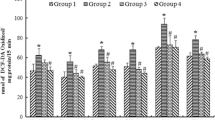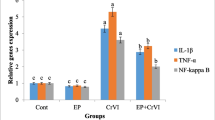Abstract
As a highly toxic environmental pollutant, methylmercury (MeHg) can cause neurotoxicity in animals and humans. Considering the antioxidant property of grape seed proanthocyanidin extracts (GSPE), this study was aimed to evaluate the effect of GSPE on MeHg-induced neurotoxicity in rats. Rats were exposed to MeHg by intraperitoneal injection (4, 12 μmol/kg, respectively) and GSPE was administered by gavage (250 mg/kg) 2 h later. After a 4-week treatment, phosphate-activated glutaminase, glutamine synthetase, glutathione peroxidase and superoxide dismutase activities, glutamate, glutamine, malondialdehyde and glutathione contents in cerebral cortex were measured. Reactive oxygen species (ROS) and apoptosis were also estimated in cells. The results showed that the MeHg-induced neurotoxicity was significantly attenuated. GSPE significantly decreased the production of ROS, counteracted oxidative damage and increased the antioxidants and antioxidant enzymes activities in rats prior to MeHg exposure. Moreover, the effects on the rate of apoptotic cells and the disturbance of glutamate homeostasis were correspondingly modulated. These observations highlighted the potential of GSPE in offering protection against MeHg-induced neurotoxicity.




Similar content being viewed by others
References
Ercal N, Gurer-Orhan H, Aykin-Burns N (2001) Toxic metals and oxidative stress part I: mechanisms involved in metal-induced oxidative damage. Curr Top Med Chem 1:529–539
Clarkson TW, Magos L, Myers GJ (2003) The toxicology of mercury—current exposures and clinical manifestations. N Engl J Med 349:1731–1737
Aschner M, Syversen T, Souza DO, Rocha JB, Farina M (2007) Involvement of glutamate and reactive oxygen species in methylmercury neurotoxicity. Braz J Med Biol Res 40:285–291
Allen JW, Mutkus LA, Aschner M (2001) Methylmercury-mediated inhibition of 3H-d-aspartate transport in cultured astrocytes is reversed by the antioxidant catalase. Brain Res 902:92–100
Allen JW, Shanker G, Tan KH, Aschner M (2002) The consequences of methylmercury exposure on interactive functions between astrocytes and neurons. Neurotoxicology 23:755–759
Shanker G, Aschner M (2003) Methylmercury-induced reactive oxygen species formation in neonatal cerebral astrocytic cultures is attenuated by antioxidants. Mol Brain Res 110:85–91
Farina M, Campos F, Vendrell I, Berenguer J, Barzi M, Pons S (2009) Probucol increases glutathione peroxidase-1 activity and displays long-lasting protection against methylmercury toxicity in cerebellar granule cells. Toxicol Sci 112:416–426
Bush AI (2000) Metals neuroscience. Curr Opin Chem Biol 4:184–191
Franco JL, Braga HC, Stringari J, Missau FC, Posser T, Mendes BG, Leal RB, Santos AR, Dafre AL, Pizzolatti MG, Farina M (2007) Mercurial-induced hydrogen peroxide generation in mouse brain mitochondria: protective effects of quercetin. Chem Res Toxicol 20:1919–1926
Franco JL, Posser T, Dunkley PR, Dickson PW, Mattos JJ, Martins R, Bainy AC, Marques MR, Dafre AL, Farina M (2009) Methylmercury neurotoxicity is associated with inhibition of the antioxidant enzyme glutathione peroxidase. Free Radic Biol Med 47:449–457
Shanker G, Syversen T, Aschner JL, Aschner M (2005) Modulatory effect of glutathione status and antioxidants on methylmercury-induced free radical formation in primary cultures of cerebral astrocytes. Brain Res Mol Brain Res 137:11–22
Kaur P, Aschner M, Syversen T (2006) Glutathione modulation influences methylmercury induced neurotoxicity in primary cell cultures of neurons and astrocytes. Neurotoxicology 27:492–500
Yin Z, Milatovic D, Aschner JL, Syversen T, Rocha JB, Souza DO, Sidoryk M, Albrecht J, Aschner M (2007) Methylmercury induces oxidative injury, alterations inpermeability and glutamine transport in cultured astrocytes. Brain Res 1131:1–10
Stringari J, Nunes AK, Franco JL, Bohrer D, Garcia SC, Dafre AL, Milatovic D, Souza DO, Rocha JB, Aschner M, Farina M (2008) Prenatal methylmercury exposure hampers glutathione antioxidant system ontogenesis and causes long-lasting oxidative stress in the mouse brain. Toxicol Appl Pharmacol 227:147–154
Aschner M, Yao CP, Allen JW, Tan KH (2000) Methylmercury alters glutamate transport in astrocyte. Neurochem Int 37:199–206
Fonfria E, Vilaro MT, Babot Z, Rodriguez-Farre E, Sunol C (2005) Mercury compounds disrupt neuronal glutamate transport in cultured mouse cerebellar granule cells. J Neurosci Res 79:545–553
Juárez BI, Martínez ML, Montante M, Dufour L, García E, Jiménez-Capdeville ME (2002) Methylmercury increases glutamate extracellular levels in frontal cortex of awake rats. Neurotoxicol Teratol 5516:1–5
Allen JW, Mutkus LA, Aschner M (2001) Mercuric chloride, but not methylmercury, inhibits glutamine synthetase activity in primary cultures of cortical astrocytes. Brain Res 891(1–2):148–157
Suárez I, Bodega G, Fernández B (2002) Glutamine synthetase in brain: effect of ammonia. Neurochem Int 41(2–3):123–142
Matés JM, Pérez-Gómez C, Núñez de Castro I, Asenjo M, Márquez J (2002) Glutamine and its relationship with intracellular redox status, oxidative stress and cell proliferation/death. Int J Biochem Cell Biol 34:439–458
Houde V, Grenier D, Chandad F (2006) Protective effects of grape seed proanthocyanidins against oxidative stress induced by lipopolysaccharides of periodontopathogens. J Periodontol 77:1371–1379
Shao ZH, Becker LB, Vanden Hoek TL, Schumacker PT, Li CQ, Zhao D, Wojcik K, Anderson T, Qin Y, Dey L, Yuan CS (2003) Grape seed proanthocyanidin extract attenuates oxidant injury in cardiomyocytes. Pharmacol Res 47:463–469
Vayalil PK, Mittal A, Katiyar SK (2004) Proanthocyanidins from grape seeds inhibit expression of matrix metalloproteinases in human prostate carcinoma cells, which is associated with the inhibition of activation of MAPK and NF kappa B. Carcinogenesis 25:987–995
Bagchi D, Bagchi M, Stohs S, Ray SD, Sen CK, Preuss HG, Ann NY (2002) Cellular protection with proanthocyanidins derived from grape seeds. Acad Sci 957:260–270
Bagchi D, Garg A, Krohn RL, Bagchi M, Bagchi DJ, Balmoori J, Stohs SJ (1998) Protective effects of grape seed proanthocyanidins and selected antioxidants against TPA-induced hepatic and brain lipid peroxidation and DNA fragmentation, and peritoneal macrophage activation in mice. Gen Pharmacol 30:771–776
Ray S, Bagchi D, Lim PM, Bagchi M, Gross SM, Kothari SC, Preuss HG, Stohs SJ (2001) Acute and long-term safety evaluation of a novel IH636 grape seed proanthocyanidin extract. Res Commun Mol Pathol Pharmacol 109:165–197
Farina M, Aschner M, Rocha JB (2011) Oxidative stress in MeHg-induced neurotoxicity. Toxicol Appl Pharmacol. May 9. [Epub ahead of print].
Bagchi D, Sen CK, Ray SD, Das DK, Bagchi M, Preuss HG, Vinson JA (2003) Molecular mechanisms of cardioprotection by a novel grape seed proanthocyanidin extract. Mutat Res 523–524:87–97
Bagchi D, Garg A, Krohn RL, Bagchi M, Tran MX, Stohs SJ (1997) Oxygen free radical scavenging abilities of vitamins C and E, and a grape seed proanthocyanidin extract in vitro. Res Commun Mol Pathol Pharmacol 95(2):179–189
Adair BM, Cobb GP (1999) Improved preparation of small biological samples for mercury analysis using cold vapor atomic absorption spectroscopy. Chemosphere 38:2951–2958
Ohkawa W, Ohishi N, Yagi K (1979) Assay for lipid peroxides in animal tissues by thiobarbituric acid reaction. Anal Biochem 95:351–358
Kum-Talt L, Tan IK (1974) A new colorimetric method for the determination of glutathione in erythrocytes. Clin Chem Acta 53:153–161
Renis M, Cardile V, Russo A, Campisi A, Collovà F (1998) Glutamine synthetase activity and HSP70 levels in cultured rat astrocytes: effect of 1-octadecyl-2-methyl-rac-glycero-3-phosphocholine. Brain Res 783:143–150
Curi TC, De Melo MP, De Azevedo RB, Zorn TM, Curi R (1997) Glutamine utilization by rat neutrophils: presence of phosphate-dependent glutaminase. Am J Physiol 273:C1124–C1129
Wang H, Joseph JA (1999) Quantifying cellular oxidative stress bydichlorofluorescein assay using microplate reader. Free Radic Biol Med 27:612–616
Shanker G, Aschner JL, Syversen T, Aschner M (2004) Free radical formation in cerebral cortical astrocytes in culture induced by methylmercury. Brain Res Mol Brain Res 128:48–57
Erikson KM, Dorman DC, Fitsanakis V, Lash LH, Aschner M (2006) Alterations of oxidative stress biomarkers due to in utero and neonatal exposures of airborne manganese. Biol Trace Elem Res 111:199–215
Lora J, Alonso FJ, Segura JA, Lobo C, Márquez J, Matés JM (2004) Antisense glutaminase inhibition decreases glutathione antioxidant capacity and increases apoptosis in Ehrlich ascitic tumour cells. Eur J Biochem 271:4298–4306
Ogunlesi F, Cho C, McGrath-Morrow SA (2004) The effect of glutamine on A549 cells exposed to moderate hyperoxia. Biochim Biophys Acta 1688:112–120
Ceccatelli S, Daré E, Moors M (2010) Methylmercury-induced neurotoxicity and apoptosis. Chem Biol Interact 188:301–308
Duchen MR (2000) Mitochondria and Ca(2+) in cell physiology and pathophysiology. Cell Calcium 28:339–348
Allen JW, Shanker G, Aschner M (2001) Methylmercury inhibits the in vitro uptake of the glutathione precursor, cystine, in astrocytes, but not in neurons. Brain Res 894:131–140
Myhrstad MC, Carlsen H, Nordström O, Blomhoff R, Moskaug JØ (2002) Flavonoids increase the intracellular glutathione level by transactivation of the gamma-glutamyl cysteine synthetase catalytical. subunit promoter. Free Radic Biol Med 32(5):386–393
Fujimura M, Usuki F, Sawada M, Takashima A (2009) Methylmercury induces neuropathological changes with tau hyperphosphorylation mainly through the activation of the c-jun-N-terminal kinase pathway in the cerebral cortex, but not in the hippocampus of the mouse brain. Neurotoxicology 30:1000–1007
Joshi SS, Kuszynski CA, Benner EJ, Bagchi M, Bagchi D (1999) Amelioration of the cytotoxic effects of chemotherapeutic agents by grape seed proanthocyanidin extract. Antiox Redox Signal 1:563–570
Jia Z, Song Z, Zhao Y, Wang X, Liu P (2011) Grape seed proanthocyanidin extract protects human lens epithelial cells from oxidative stress via reducing NF-кB and MAPK protein expression. Mol Vis 17:210–217
Acknowledgments
This study was supported financially by the grants from the National Natural Science Foundation of China (No. 81172631). The authors thank Chunwei Lu from the Department of Public Health in China Medical University for his technical assistance.
Author information
Authors and Affiliations
Corresponding author
Rights and permissions
About this article
Cite this article
Yang, H., Xu, Z., Liu, W. et al. Effect of Grape Seed Proanthocyanidin Extracts on Methylmercury-Induced Neurotoxicity in Rats. Biol Trace Elem Res 147, 156–164 (2012). https://doi.org/10.1007/s12011-011-9272-x
Received:
Accepted:
Published:
Issue Date:
DOI: https://doi.org/10.1007/s12011-011-9272-x




